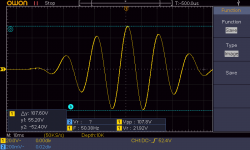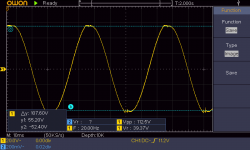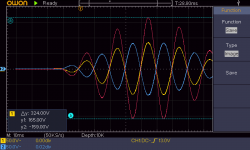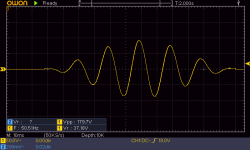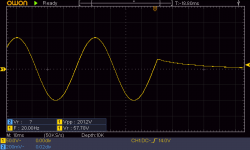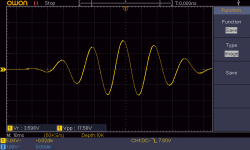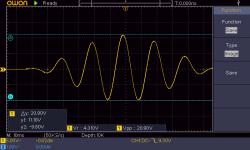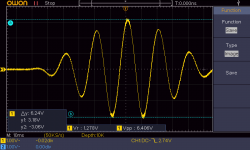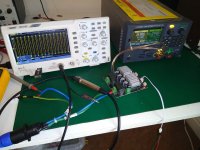So I have a Yamaha P7000S now and can confirm in home usage the fans don't even spin. Mine had been gigged (very bashed outside) but there was very little dust inside the case so I would presume that even at 'war' volume the fans don't run very fast. Its unloaded clip point is 100Vrms/200Vrms bridged so I think real world it may be more powerful than an inuke6000 which hits ~95V. I'm a bit overloaded but I hope to bench test both amps next month.
I also have a crown CTS4200 in which at idle the fan does not spin (it defiantly has a working fan as it momentarily spins on startup). However googling this amp shows people fan swapping on it to make it quieter, so there may be a firmware difference between earlier an later productions of this amp. The fan is controlled using a buck converter running from a PIC microcontroller which takes in temp sensor data from all over the amp so its a bit opaque as to what would actualy turn on the fans. This will also be bench tested so I will have a better idea soon as to what the fan behavior is.
I also have a crown CTS4200 in which at idle the fan does not spin (it defiantly has a working fan as it momentarily spins on startup). However googling this amp shows people fan swapping on it to make it quieter, so there may be a firmware difference between earlier an later productions of this amp. The fan is controlled using a buck converter running from a PIC microcontroller which takes in temp sensor data from all over the amp so its a bit opaque as to what would actualy turn on the fans. This will also be bench tested so I will have a better idea soon as to what the fan behavior is.
Ha ha haBehringer in a studio!!! (I can laugh...) I own 5 Behringer units for my home stereo and they probably cost less than what goes into an engineer's nose on one busy night

This made me laugh out loud as I know it's true 😄
Take a look at some Chevin amps, the fans are very quiet at normal listening levels. Or MC2 and replace the fans with Noctua.
I did some testing on my CTS4200 and the fan noise is very dependent on load. For light load on a single channel it does not spin, however running a single channel at full power into 4R the amp quickly turns into a jet engine and thermally limits after a couple of minutes. Clipping point for a single channel into 4R is 40Vrms giving 400W, clip lights only illuminate under heavy clipping.
Hi kipman725, am curious to see the result as I have the Yamaha p7000s. thanksI hope to bench test both amps next month.
Crown CTS4200 tests
Here are some super basic tests on the CTS4200. Test condition is just CH1 loaded with a 4ohm test load.
1) 50Hz CEA-2010 waveform with gain adjusted such that waveform is just beginning to clip. 108Vpp, 363W/4R.
2) 20Hz tone burst at end of 100 cycles (5s), I wish I could show the full burst but my scope has tiny memory. Its a quite clipped but that me not bothering to set the gain exactly correct. Basically this is the same at the start and end of the 5s burst. The fan did not turn on doing these bursts, it only turns on when the output is run at this level for longer time periods.
This is an amplifier with a switch mode supply and class AB bipolar amplifier so these results are to be expected as the power supply is regulated and a single amp channel is insufficient to force it out of regulation. The spec for this amp claims 270W/4R for a single driven channel at 0.1% THD, it would seem to be more than capable of meeting this spec.
The bigger amps are going to need me to borrow a high voltage differential probe.
Here are some super basic tests on the CTS4200. Test condition is just CH1 loaded with a 4ohm test load.
1) 50Hz CEA-2010 waveform with gain adjusted such that waveform is just beginning to clip. 108Vpp, 363W/4R.
2) 20Hz tone burst at end of 100 cycles (5s), I wish I could show the full burst but my scope has tiny memory. Its a quite clipped but that me not bothering to set the gain exactly correct. Basically this is the same at the start and end of the 5s burst. The fan did not turn on doing these bursts, it only turns on when the output is run at this level for longer time periods.
This is an amplifier with a switch mode supply and class AB bipolar amplifier so these results are to be expected as the power supply is regulated and a single amp channel is insufficient to force it out of regulation. The spec for this amp claims 270W/4R for a single driven channel at 0.1% THD, it would seem to be more than capable of meeting this spec.
The bigger amps are going to need me to borrow a high voltage differential probe.
Attachments
Last edited:
P7000s test results
Here are the test results for the P7000s. Unfortunately repeated 20Hz sine wave bursts appears to have damaged* it when bridged into 4 ohms (the one burst rating in the manual made me curious).
1 channel / 50Hz CEA-2010 / 4 ohm = 179.7 Vpp = 1008 W
1 channel / 20Hz sine at end of 100 cycles / 200 Vpp = 1250 W
Bridged / 50Hz CEA-2010 / 4 ohm = 324 Vpp = 3280 W
I used the maths function to make a pseudo differential probe for the bridged burst result so the individual traces will have ground noise on them that's canceled in the maths trace.
So quite a good amp for getting a lot of power into 8 ohms (probably around 2 kW but I don't have a load to test this) or 2*1kW into 4 ohms.
*Took the top off to start fixing it and it now powers up again so presumably some kind of protection was triggered, still don't bridge it into 4ohms...
Here are the test results for the P7000s. Unfortunately repeated 20Hz sine wave bursts appears to have damaged* it when bridged into 4 ohms (the one burst rating in the manual made me curious).
1 channel / 50Hz CEA-2010 / 4 ohm = 179.7 Vpp = 1008 W
1 channel / 20Hz sine at end of 100 cycles / 200 Vpp = 1250 W
Bridged / 50Hz CEA-2010 / 4 ohm = 324 Vpp = 3280 W
I used the maths function to make a pseudo differential probe for the bridged burst result so the individual traces will have ground noise on them that's canceled in the maths trace.
So quite a good amp for getting a lot of power into 8 ohms (probably around 2 kW but I don't have a load to test this) or 2*1kW into 4 ohms.
*Took the top off to start fixing it and it now powers up again so presumably some kind of protection was triggered, still don't bridge it into 4ohms...
Attachments
Last edited:
Here are the test results for the P7000s.
So quite a good amp for getting a lot of power into 8 ohms (probably around 2 kW but I don't have a load to test this) or 2*1kW into 4 ohms.
That is how I use my copies... feeding individual 4ohm sub drivers and they do a great job with it. FWIW it's long been my understanding that these were never designed for bridged 4 ohm operation, the documents and advertising also suggest that is the case.
That is interesting, I haven't experienced that with these Yamahas because the only time I have pushed them that hard is with speakers attached so any noise generated gets drowned out, but I have experienced that phenomena with other large PA amps so I don't think it is unique.
The older Samson servo range was fanless, I have a Servo 550 powering my subs at the moment. 275 per channel into 4 ohms.
Rob.
Samson — Servo 550
Rob.
Samson — Servo 550
The older Samson servo range was fanless, I have a Servo 550 powering my subs at the moment. 275 per channel into 4 ohms.
Rob.
Samson — Servo 550
And in my experience ran bloody hot when pushed! 🔥 🔥 🔥
Samson servo 500/550 nice little amplifier. Little bit flimsy knobs and plastic front cover but sound quality is flawless.
My current home setup uses Servo 500 for bass/low mids and Crown DC300A for mid/highs (JBL 2445J + 2380A). Two way active system.
Both amps has also great s/n ratio which is important when using high sensitivity speakers.
My current home setup uses Servo 500 for bass/low mids and Crown DC300A for mid/highs (JBL 2445J + 2380A). Two way active system.
Both amps has also great s/n ratio which is important when using high sensitivity speakers.
CDi1000
I used a 100x diffirential probe for these measurements so multiply all voltages by 10x in the scope traces. This amp appears to be a class-AB with SMPS in that it can (with one channel loaded with 4ohm) sustain peak output indefinitely. I did not try sustained sine waves in bridged mode as although I am relatively confident from my experience of Crown amps that it would survive I didn't want to take the risk. This amp has a built in defeat-able DSP with crossover, delay and PEQ which is quite handy.
During light use the fan stays off (yay). When the amp is running at full output the fan turns on after about 30s and stays on for a couple of mins after power output is reduced. It is also loud enough it would be very annoying listening to quiet music.
bridge = 209vpp = 1364W (4ohms) (seems to be current limited)
single channel = 176vpp = 968W (4ohms)
so power output is in line with crown numbers, single channel stronger than expected probably because of the low distortion threshold Crown use. I did notice as per the CTS4200 that clipping had to become quite extreme before the clip lights started to flash.
I used a 100x diffirential probe for these measurements so multiply all voltages by 10x in the scope traces. This amp appears to be a class-AB with SMPS in that it can (with one channel loaded with 4ohm) sustain peak output indefinitely. I did not try sustained sine waves in bridged mode as although I am relatively confident from my experience of Crown amps that it would survive I didn't want to take the risk. This amp has a built in defeat-able DSP with crossover, delay and PEQ which is quite handy.
During light use the fan stays off (yay). When the amp is running at full output the fan turns on after about 30s and stays on for a couple of mins after power output is reduced. It is also loud enough it would be very annoying listening to quiet music.
bridge = 209vpp = 1364W (4ohms) (seems to be current limited)
single channel = 176vpp = 968W (4ohms)
so power output is in line with crown numbers, single channel stronger than expected probably because of the low distortion threshold Crown use. I did notice as per the CTS4200 that clipping had to become quite extreme before the clip lights started to flash.
Attachments
3e Audio EAUMT-0140-2-A (TPA3251 based)
This is a class-D chip amp not a conventional PA amplifier but I am using them in a battery powered PA application and they are silent and cheap (although by far not the cheapest TPA3251 amplifier). I went with the TPA3251 rather than the TPA3255 mainly due to the current supply chain issues and a desire for minimum idle power consumption.
Initially I had issues with the amplifier shutting down and displaying a fault light when I ramped up the power. This turned out to be due to the output of my audio interface not been a true balanced signal which is not normally an issue but in this amplifier each leg of the balanced signal directly drives each side of the bridge so one side of the bridge was held at gnd while the other drove it which apart from inducing early clipping was causing the amplifier to trip into fault mode. So I conducted these tests in SE mode using only the + signal and gnd. I did not have any further shut down issues.
The amplifier seems very efficient not getting more than warm when running at full sine wave power for minutes at a time. Sine wave output power is the same as burst.
64vpp = 128W (4 ohms).
This is a class-D chip amp not a conventional PA amplifier but I am using them in a battery powered PA application and they are silent and cheap (although by far not the cheapest TPA3251 amplifier). I went with the TPA3251 rather than the TPA3255 mainly due to the current supply chain issues and a desire for minimum idle power consumption.
Initially I had issues with the amplifier shutting down and displaying a fault light when I ramped up the power. This turned out to be due to the output of my audio interface not been a true balanced signal which is not normally an issue but in this amplifier each leg of the balanced signal directly drives each side of the bridge so one side of the bridge was held at gnd while the other drove it which apart from inducing early clipping was causing the amplifier to trip into fault mode. So I conducted these tests in SE mode using only the + signal and gnd. I did not have any further shut down issues.
The amplifier seems very efficient not getting more than warm when running at full sine wave power for minutes at a time. Sine wave output power is the same as burst.
64vpp = 128W (4 ohms).
Attachments
They may have changed the fan curve on the CTs amps to try and make them more reliable... I know someone who works at a venue that has been pretty unimpressed with the reliability of the Crown CTs amps.
As for noisy, the worst I have seen is the Macro-Tech 3600VZ, which is about on part with your average server. It is somewhat worse than a BSS EPC780 in that regard, but the BSS is such an amazing amplifier that it can be forgiven for its fan noise (unlike the Crown).
The QSC EX800 does not run its fan until it gets hot, so it probably falls under the category of "silent".
As they go, the MC2 MC series isn't terrible, but you may want to replace the fans with quieter ones if you aren't pushing the amplifier too hard.
As for noisy, the worst I have seen is the Macro-Tech 3600VZ, which is about on part with your average server. It is somewhat worse than a BSS EPC780 in that regard, but the BSS is such an amazing amplifier that it can be forgiven for its fan noise (unlike the Crown).
The QSC EX800 does not run its fan until it gets hot, so it probably falls under the category of "silent".
As they go, the MC2 MC series isn't terrible, but you may want to replace the fans with quieter ones if you aren't pushing the amplifier too hard.
Thanks for the info. The CTS4200 controls fan speed using a PIC chip so its certainly possible an update was made to the firmware. My particular CTS4200 I got cheaply as it had inconsistent volume on some of the channels. I traced this back to the 4/8/10/100V selector switch, this switch is a complicated custom switch and had sticky gunk all over the contacts. To fix it I had to remove the switch circuit board and soak it in contact cleaner and then blow out repeatedly with canned air. Its been reliable for me since then.
I've torn down a couple failed CTs amps (they aren't worth my time to fix), and all of them came down to SMPS failures. My suspicion is that Crown figured out this was a problem and increased the fan speed on newer amps to try and reduce the failure rate. Most of these amps were used in installs, so they tend to run for long periods of time. As such, cooling can make a big difference in terms of reliability.

the cooling on the PSU is a bit rubbish even if the fan was working. My CTS4200 has laminated carboard ducting around the heatsinks to improve cooling. I don't understand Crowns design choices with these amps mixing an SMPS with class-AB when they had previously developed amps like the K2 and so could have made them class-D, increased efficiency and reduced costs.
- Home
- Live Sound
- PA Systems
- Quiet PA amps
